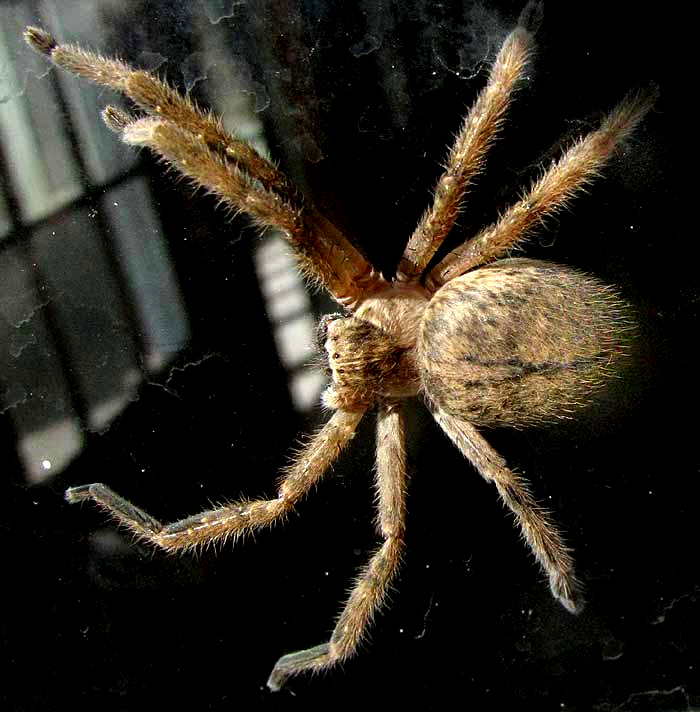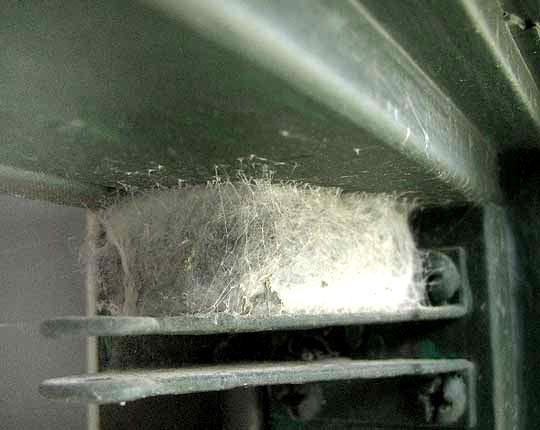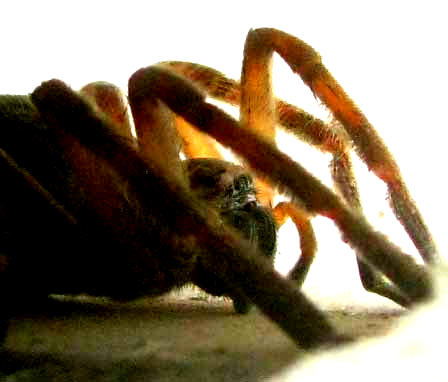Excerpts from Jim Conrad's
Naturalist Newsletter

from the November 11, 2012 Newsletter issued from the valley of the Dry Frio River in northern Uvalde County, southwestern Texas, on the southern border of the Edwards Plateau; elevation ~1750m (~5750 ft); N29.62°, W99.86°; USA
GIANT CRAB SPIDER
I was painting the outside of a house when my painting buddy let out a yelp followed by a "You have to come see this." The thing to be seen is shown above.
My painting buddy had been running his finger below some weatherboarding to clean it out, and that spider had skittered from his shelter onto the glass window. It was a very big, hairy one, about the size of a small tarantula and nearly as hairy, but something about it didn't look like a tarantula, despite its two-inch (5cm) leg span. You can see what seemed most unlike a tarantula to me below:

It's the eyes. All the tarantulas I've seen have their eight tiny eyes clustered closely together in front, but this window-perching spider's eyes are fairly large and spread across a wide "face."
By the way, in that picture the eyes appear above the horizontal band across the "face." The large, black items pointed downward are the chelicerae, which are mouthparts, at the bottom of which arise the fangs, which are tapering, curved needlelike affairs with which venom is injected into the spider's prey.
Volunteer identifier Bea in Ontario figured out this unusual spider pretty fast. It's the Giant Crab Spider, OLIOS GIGANTEUS. Just last week in our Newsletter we looked at a more typical crab spider, the Ground Crab Spider, which you can compare at http://www.backyardnature.net/n/a/xysticus.htm.
Besides both spiders being found on the walls of the same old house in Texas, other similarities confirm their crab-spiderness, including the manner in which they spread wide their legs, move sideways so easily, and construct no webs. Of the more than 2000 crab spider species in the world, the Giant Crab is one of the very largest. I've read that its bite can be a little painful, but it's not dangerous to humans.
As is typical for crab spiders, the Giant Crab hunts for small prey, mostly on the ground and it prefers to hunt at night. In Spanish its name is Cazadora del Desierto, or Desert Hunter. In fact, the Giant Crab mainly occurs in arid northern Mexico, extending into the US only from southern California up to Nevada and over here to southwestern Texas.
One other feature of Giant Crab Spiders setting them apart from their congeners is the ease -- despite their large size -- with which they climb smooth, vertical surfaces. How that big spider stuck to the window of the house we were painting I just can't say.
from the October 20, 2013 Newsletter issued from the valley of the Dry Frio River in northern Uvalde County, southwestern Texas, on the southern border of the Edwards Plateau; elevation ~1750m (~5750 ft); N29.62°, W99.86°; USA
GIANT CRAB SPIDER IN RETREAT
Neighbor Ron told me about a large, silken cocoon built between horizontal metal plates serving as part of a door-hinge assemblage at the local park restroom. That's the two-inch long (5cm) cocoon below:

Opening the bathroom's door caused one side of the cocoon to pull away to reveal the cozy occupant, as shown below:

That's a close-up of the spider's face below.

We've all seen spiders' egg bags and webs of silk, but this was the first time I'd found a mature spider inside a closed silk cocoon. I hadn't known that spiders could do that. Drawing a blank on the matter, I uploaded the above photos to the spider identification forum at https://spiderid.com/.
Within a couple of hours an identification was posted, and our spider turned out to be a species we've already met, but not from the side as in our picture. It was the Giant Crab Spider, Olios giganeus, for whom we have some nice pictures.
This Southwestern US and Mexican, arid-land, nocturnal species is known to spin silken "retreats" in which it may spend the day, or to complete molting. Also, the female may spin such a retreat to stay in as she guards her egg sac and the spiderlings who emerge from the sac.